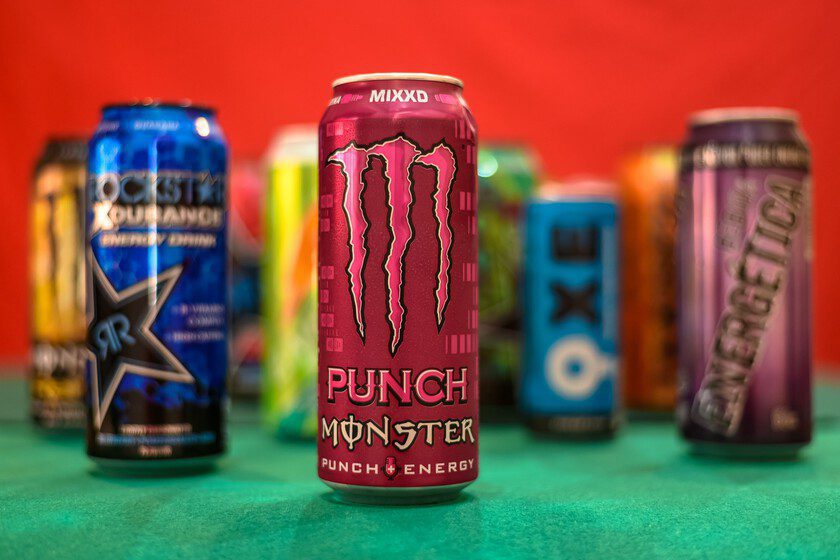Galicia he works in a law that allows minors to “restrict the consumption” of energy drinks, and while it’s unclear how it will do so (or if it has the authority to do so), the mere intention to address the problem brings to the table something we’ve known for years: that we have very serious problem with energy drinks.
A very serious problem? And 45% of Spanish students between the ages of 14 and 18 regularly drink energy drinks. These are data from the latest survey on drug use in secondary education in Spain by the Ministry of Health. If we widen the focus and go to Europe, 10 years ago EFSA said that 68% of European teenagers regularly consume these drinks.
The image of children with huge 500ml tins in bright colors has become iconic, and between 2006 and 2014 alone consumption of these products in countries such as the UK increased by 155%.
But wait a minute… what is an energy drink This is a great question because these products are an example of a concept book where we are clear as long as no one asks us for an operational definition. That is, why does taurine soft drink and cola not (if they both have the same amount of sugar)? Why an energy drink, yes; but coffee, no (if the latter contains more caffeine than the former)?
In our defense, I will say that it is not easy to precisely define this category of products, but it is clear that there are a number of properties that distinguish them from others: from the amount of D-glucuronolactone (i.e. “fast absorption” of sugar”) to the presence of “taurine, vitamins and herbal extracts such as guarana and ginseng.”
But the key fact is usually the high caffeine content.
Caffeine, lots of caffeine. “A can of about 475 ml of typical BE contains 70 to 140 mg of caffeine. To give an idea, a similar volume of soda contains about 25 mg, black tea about 55 mg and coffee 85 to 100 mg,” they recall in the Spanish Society of Cardiology.
That’s part of the controversy, no doubt about it. The same European regulation removed coffee or tea drinks from the label of highly caffeinated drinks. Because? Although there are explanations for all tastes and it is undeniable that (as with the regulation of alcoholic beverages) custom, industry and economics weigh heavily in these decisions, the fact that 500ml cans are expanding (that means 160mg of caffeine and 75 grams of sugar: three coffees and 15 sugars) does not help promote responsible consumption.
And therein lies the key… According to the Spanish Food Safety Authority (AESAN), “the consumption of more than 60 milligrams of caffeine in adolescents aged 11 to 17 years (about 200 milliliters of an energy drink with 32 mg caffeine/100 ml) can cause sleep disturbances.” This already gives us a dimension of the problems that can be caused, but it doesn’t stop there.
“From 160 milligrams of caffeine (500 milliliters of an energy drink with 32 mg of caffeine/100 ml) (the consumption of these drinks) can cause general adverse health effects: psychological effects and behavioral changes and cardiovascular disorders.”
In general, sleep deprivation is associated with immunological, metabolic, cardiovascular, emotional, and cognitive problems; with disorders such as diabetes or obesity. This makes us more tired and irritable, our stress levels increase, and we take more risks and make more mistakes. This does not mean that we will develop any of these diseases from consuming energy drinks, but it is clear that it puts us in a complicated situation.
An increasingly solid consensus among experts. “Energy drink consumption, even infrequent consumption, was associated with several negative health indicators. The reporting of several health-threatening behaviors increased with frequency of energy drink consumption.” These are the conclusions of Maija Puupponen and her team at the University of Jyväskylä.
Puupponen’s work focuses on adolescence, but the effects go much further. As explained by Julio Basulto, at the beginning these drinks are correlated “with a significant increase in the likelihood of insomnia, nervousness, anxiety, depression, impulsivity and poor academic performance, among other things”.
In addition, its frequent consumption can cause “hypertension, loss of bone density, osteoporosis, poor psychological, physical, educational and general well-being and other consequences”. Basically, the big problem with energy drinks is that it is a “prestige” cultural practice among young people that is associated with a huge amount of risky behavior. That’s why it makes sense to trim corners.
However, the problem is much deeper.. And although experts are focusing on energy drinks because they are (as we can see) a very clear focus of problems, this is only a small step on a much longer journey.
It’s been more than a decade (when it was discovered that the sugar industry paid scientists for decades and funded hundreds of studies that blamed fat for heart disease and exonerated sugar) that the idea that “sugars are the new tobacco” has been around. table. It was the time of taxes on sugary drinks, which are gradually getting off the current train.
It seems like an opportune time for the debate to resurface. We are ten years late
In Xataka | It’s not just sugar, hundreds of industries are trying to trick us: we have a problem and it’s time to find a solution
Image | Jorge Franganillo

